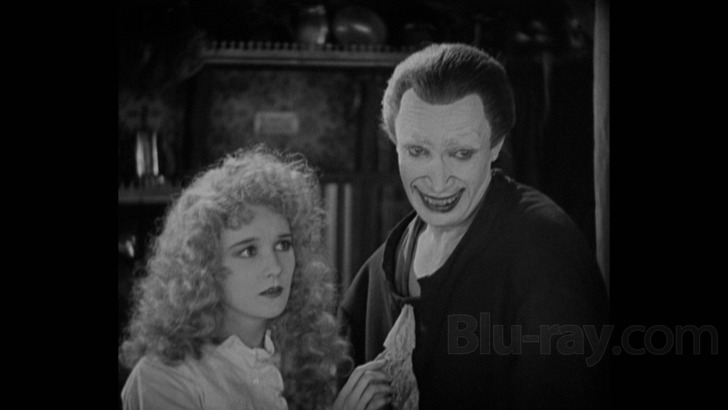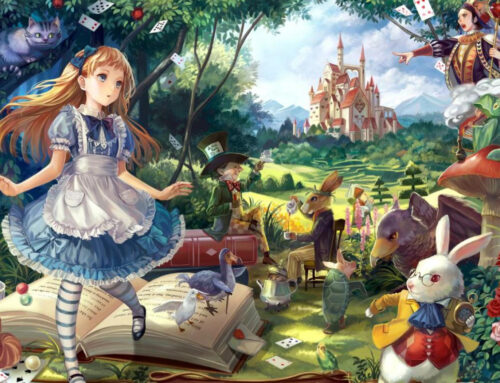“The Man Who Laughs,” a silent film released in 1928, stands as a haunting and visually captivating masterpiece of early cinema. Directed by German expressionist filmmaker Paul Leni and based on Victor Hugo’s novel of the same name, the movie tells a tale of tragedy, love, and the indomitable human spirit. With its remarkable cinematography, striking performances, and timeless themes, “The Man Who Laughs” has left an indelible mark on the history of cinema.
Watch the video review on the original 1928 movie and 2012 remake here.
The Story:
Set in 17th-century England, the film follows the tragic life of Gwynplaine, a young nobleman who, as a child, was disfigured with a permanent grin by a vengeful king. Gwynplaine (played by Conrad Veidt) grows up as a traveling performer in a carnival, wearing a grotesque mask-like grin while harboring a wounded soul. His path crosses with Dea (Mary Philbin), a blind girl who sees past his disfigurement and falls in love with him. Together, they navigate a world of cruelty, political intrigue, and forbidden love, culminating in a poignant and emotionally charged climax.
Visual and Cinematic Brilliance:
“The Man Who Laughs” is a triumph of visual storytelling. Paul Leni’s expertise in German expressionism shines through, creating an otherworldly and haunting atmosphere throughout the film. The iconic makeup design for Gwynplaine, with its grotesque grin, has become an enduring symbol of silent cinema. The film’s cinematography expertly utilizes shadows, contrast, and unique compositions to emphasize the emotional intensity of the narrative, immersing the audience in a dark and ethereal visual experience.
Performance and Emotion:
Conrad Veidt delivers a mesmerizing performance as Gwynplaine, capturing both the physical torment and the emotional turmoil of his character. Veidt’s ability to convey deep, nuanced emotions through his expressive eyes, despite the mask-like grin, is a testament to his extraordinary talent. Mary Philbin’s portrayal of Dea, with her delicate and tender performance, adds a poignant layer of innocence and love to the film. The chemistry between the two leads evokes a profound sense of empathy and compassion from the audience, enhancing the emotional impact of the story.
Themes and Significance:
Beneath its visually striking façade, “The Man Who Laughs” explores timeless themes of social inequality, resilience, and the power of love in the face of adversity. It delves into the human condition, examining the depths of suffering and the transformative power of compassion and understanding. The film prompts reflection on the nature of beauty, the masks we wear, and the societal forces that shape our lives. Its exploration of societal injustice and the impact of appearances remains relevant to this day, making it a profoundly resonant piece of cinema.
Legacy and Influence:
“The Man Who Laughs” left an indelible mark on the history of cinema, influencing filmmakers for generations to come. Its artistic and technical achievements continue to inspire filmmakers and cinephiles alike. Moreover, the film’s visual and narrative elements have had a lasting impact on the horror genre, influencing subsequent works, including the iconic appearance of the Joker in Batman comics and films.
“The Man Who Laughs” stands as a haunting and visually stunning triumph of silent cinema. Its enduring legacy is a testament to the power of storytelling, the evocative nature of visual expression, and the ability of cinema to explore complex themes that resonate across generations.
A Dark and Haunting Rendition:
The 2012 remake of “The Man Who Laughs” (original French title: “L’homme qui rit”) was directed by Jean-Pierre Améris and showcased a visually striking interpretation of the tragic tale. Set in 17th-century England, the film tells the story of Gwynplaine, a young man disfigured with a permanent, grotesque smile as a result of a cruel act of revenge. As Gwynplaine navigates a world that alternates between beauty and darkness, the film immerses viewers in a haunting and atmospheric experience.
Emotionally Charged Performances:
Central to the success of the 2012 remake of “The Man Who Laughs” are the powerful performances that breathe life into its compelling characters. Gérard Depardieu delivers a captivating portrayal of Ursus, a kind-hearted entertainer who becomes a father figure to Gwynplaine, played by Marc-André Grondin. Grondin’s nuanced performance captures the anguish and resilience of Gwynplaine, making him a tragic and empathetic figure. Emmanuelle Seigner shines as the enigmatic and beautiful Dea, who brings light and hope into Gwynplaine’s dark world. The performances in the film add depth and emotional resonance, allowing audiences to connect with the characters’ struggles and triumphs.
A Reflection on Humanity:
At its core, “The Man Who Laughs” is a thought-provoking exploration of the human condition and the society that shapes it. The film delves into themes of appearance versus reality, social inequality, and the search for identity and acceptance. It poses questions about the nature of humanity and the effects of cruelty and compassion on individuals’ lives. Through its compelling narrative and visual storytelling, the 2012 adaptation prompts viewers to reflect on the complexities of human existence and the resilience of the human spirit.
Paying Homage to Victor Hugo’s Masterpiece:
As a remake of a classic tale, the 2012 adaptation of “The Man Who Laughs” pays homage to the enduring legacy of Victor Hugo’s original novel. It captures the essence of Hugo’s exploration of societal injustices, the transformative power of love, and the indomitable spirit of the human soul. While offering its unique visual interpretation, the film remains faithful to the underlying themes and the emotional resonance of the source material, ensuring that the spirit of Hugo’s work remains intact.
The 2012 remake of “The Man Who Laughs” is a haunting and visually stunning adaptation that brings Victor Hugo’s timeless tale to life for contemporary audiences. With its atmospheric cinematography, exceptional performances, and thought-provoking exploration of universal themes, the film stands as a testament to the enduring power of Hugo’s masterpiece. By capturing the tragedy and resilience of its central characters, it reminds us of the inherent humanity that lies within us all, even in the face of adversity and the darkest of circumstances.










